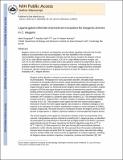Ligand-Gated Chloride Channels Are Receptors for Biogenic Amines in C. elegans
Author(s)
Ringstad, Niels; Abe, Namiko; Horvitz, Howard Robert
DownloadHorvitz_Ligand-gated.pdf (835.6Kb)
OPEN_ACCESS_POLICY
Open Access Policy
Creative Commons Attribution-Noncommercial-Share Alike
Terms of use
Metadata
Show full item recordAbstract
Biogenic amines such as serotonin and dopamine are intercellular signaling molecules that function widely as neurotransmitters and neuromodulators. We have identified in the nematode Caenorhabditis elegans three ligand-gated chloride channels that are receptors for biogenic amines: LGC-53 is a high-affinity dopamine receptor, LGC-55 is a high-affinity tyramine receptor, and LGC-40 is a low-affinity serotonin receptor that is also gated by choline and acetylcholine. lgc-55 mutants are defective in a behavior that requires endogenous tyramine, which indicates that this ionotropic tyramine receptor functions in tyramine signaling in vivo. Our studies suggest that direct activation of membrane chloride conductances is a general mechanism of action for biogenic amines in the modulation of C. elegans behavior.
Date issued
2009-07Department
Massachusetts Institute of Technology. Department of Biology; McGovern Institute for Brain Research at MITJournal
Science
Publisher
American Association for the Advancement of Science (AAAS)
Citation
Ringstad, N., N. Abe, and H. R. Horvitz. “Ligand-Gated Chloride Channels Are Receptors for Biogenic Amines in C. elegans.” Science 325, no. 5936 (July 2, 2009): 96-100.
Version: Author's final manuscript
ISSN
0036-8075
1095-9203